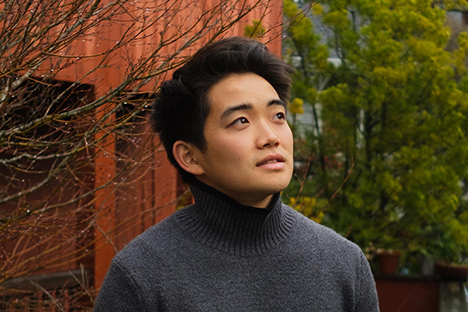
2021 Dorothea Lange Fellow
Kori Suzuki
Crouched behind a tree in Minnesota’s Brooklyn Center last spring, Kori Suzuki wore a gas mask while taking photos of a chaotic scene.
To his right, a crowd of residents and Black Lives Matter groups protested the killing of Daunte Wright, a 20-year-old Black man from Minneapolis who was fatally shot during a traffic stop on April 11, 2021. And to Suzuki’s left, a squad of armed law enforcement officers cloaked behind a chain link fence surrounding the city’s police department.
Tensions were high that week, and police took crowd control tactics to another level, firing off flash grenades and tear gas that tinged the air. Suzuki said protesters and reporters alike were beaten to the ground, pepper sprayed, handcuffed and arrested.
“There wasn’t any concern given to people’s well-being,” said Suzuki, who at the time was a student journalist at Macalester College in St. Paul. “It felt very much like just a show of force meant to stamp out any resistance.”
Officers also fired rubber bullets at the crowd to subdue anyone the police deemed a threat. One struck Suzuki in the leg. He keeps the bullet to remember what happened.
“I guess I got a little too close, but I was thankful that it wasn’t something worse,” said Suzuki, a first-year graduate student in UC Berkeley’s journalism school. “I know protesters and reporters that left with broken hands or health issues from inhaling tear gas. … It was a very scary scene.”
For Suzuki, that night was the culmination of a yearlong series of photos he produced starting in May 2020 that won him Berkeley’s 2022 Dorothea Lange Fellowship, a prize for faculty or graduate students who demonstrate outstanding work in documentary photography and have a creative plan for their future work.
His coverage captured a year of tumultuous racial justice protests in Minnesota that were in response to the high-profile police killings of Black men and women who included Breonna Taylor, Elijah McClain, Daunte Wright and George Floyd.
Berkeley Journalism adjunct professor Jeremy Rue recommended Suzuki for the fellowship, referring to him as “a journalist of exceptional quality and maturity, showing a level of empathy and clarity of thought.
“These photographs are the best demonstration of Kori’s visual brilliance, his keen eye to understand composition and light, and his fearlessness to make stirring photographs in the heat of difficult moments when commotion and danger abound.”
Suzuki began photographing protests on May 26, 2020, a day after the shocking video surfaced of Floyd pleading for Derek Chauvin, a white Minneapolis police officer, to take his knee off of his neck.
Suzuki, who had been living in the Twin Cities for close to three years, grabbed his camera and rode his bicycle five miles down to the corner of East 38th Street and Chicago Avenue when he heard people were gathering to protest the day after Floyd died.
There, he found hundreds of people honoring Floyd and protesting his death. From there, some residents would move to the Minneapolis Police Department’s Third Precinct where they met with a substantial law enforcement presence.
With no experience covering breaking news, Suzuki took out his camera.
“The entire country was watching,” said Suzuki. “So, I just tried to capture as much of it as I could for students and local residents to see.”
Suzuki’s photographs were published by his student newspaper, The Mac Weekly. As protests continued in the days and weeks that followed, Suzuki continued his coverage, not just as a reporter, but as a resident of the Twin Cities.
He began to develop relationships with local activists and journalists. He’d go to community gatherings to talk to his neighbors and other residents on a daily basis. Whether they were gardening or going to the grocery store, Suzuki got to know people in the community.
When a protest was in the works, he would often find out through local social media groups or word-of-mouth. This sometimes let him photograph spaces that other media may not have known about.
“I hope it really made people feel more comfortable around me because I wasn’t just coming into the community to tell a story, then be gone the next day,” Suzuki said. “Like other local photographers, I was there to capture images of a time and place that I lived in.”
While developing such a connection to the community he was covering, Suzuki said, he was impacted by the emotions of the people he was photographing. Though some journalists feel such connection can affect their ability to be fair and impartial, Suzuki thinks it makes his work more genuine.
“I feel like there is room to be both a person and a photographer,” he said. “And I think bringing your whole self to the moment helps you to be more empathetic to what is going on around you.”
As a Japanese American, Suzuki said he has struggled with being a photographer telling stories about the Black Lives Matter movement. “I don’t want to take up too much space in the conversation,” he said.
This summer, Suzuki will use the $4,000 Lange grant for a documentary photography project about 20,000 Japanese Americans who were stranded in Japan during World War II.
One of those “Strandees” was Suzuki’s grandmother, who was born in America and marooned in Tokyo during World War II. He hopes to interview and photograph others with similar stories.
“This is a very personal story for me, but I think this story connects with my past work, in that, similarly, I want to represent people in the most complete way possible,” said Suzuki. “You want someone to see an image of a person and be able to know their story and hear their voice through the photograph.”
